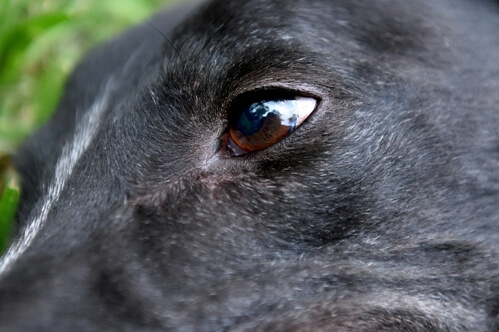Pannus is a disorder that affects the eye of the greyhound, and will eventually lead to blindness if it’s not managed. It is not painful in its early stages, causes no discharge from the eye, and may be hard to see unless you look closely at your greyhound’s eyes in a good light. If it is not diagnosed or treated, the disease will slowly cover the clear part of the eye (the ‘cornea’) until the dog can no longer see.
Pannus is seen most commonly in German Shepherd’s, but is also found in Collies, Poodles, Dachshunds and Greyhounds. There is thought to be a significant genetic inheritance, with certain families and lines within a breed more severely affected, but environmental factors also play a part in the development of the disease.

What does it look like?
Pannus symptoms generally start to appear when the dog reaches 2-5 years of age. In the beginning you may only notice that the edge of the cornea seems more pigmented (coloured) than before – kind of like ‘freckles’ developing near the edge of the eye – or there may be a hazy/greyish colour to the edge of the clear part of the eye. Generally the disease will occur in both eyes, starting at about the same time, but the lesions do not necessarily look the same.
As the disease progresses, Pannus lesions may simply look like brown pigment ‘growing’ onto the surface of the eye, or it may appear more inflamed with a ‘greyish-pink’ colour (which is the eye’s version of scar tissue). If you look closely, you might even see small blood vessels growing onto the eye surface. The colour change to the clear part of the eye starts at the outside edges and spreads inwards until the entire eye surface is covered, leaving no clear window for light to enter the eye – making the dog blind.
What causes it?
Pannus is thought to be an auto-immune disease. This means the body actually starts to attack itself. The genetic predisposition to develop pannus is inherited – so it tends to affect certain breeds and certain families within these breeds more than others.
The other factor thought to contribute to pannus is exposure to Ultra-Violet (UV) light. This exposure to UV light is thought to trigger the start of the reaction, or to make the reaction worse, so it is important to keep affected dogs out of bright light, especially in the summer months when the UV level is high. Even if exposure to UV light is not the cause of the disease, the rate of progression increases with exposure to high levels of UV light (from sun light, or reflected light from water).
Can it be treated?
Once the disease has started, there is no ‘cure’ that completely eliminates pannus. All treatments are directed at slowing the progression of the pigmented lesions and to prevent flare-ups. The most commonly used treatment is cortisone eye drops, which are administered daily. The cortisone slows the immune reaction that causes the pigment, and hence slows the progression of the disease. Cortisone may also be combined with cyclosporine drops which also help control the symptoms.
Should greyhounds with pannus be bred from?
Ideally, no greyhound with pannus would be used at stud. Unfortunately, because of its later onset, there are some litters bred from affected animals which may not have had any eye lesions at the time of breeding. This means that the disease continues to be present within the gene pool.
What should I do if I suspect one of my greyhounds may be affected by pannus?
The first thing to do is to consult your veterinarian. They will be able to do an eye examination, and discuss the disease with you. They can also refer you to a veterinary ophthalmologist (eye specialist for dogs) who can give more specific advice and recommend treatments for more severe cases. Getting to the disease early gives the best chance of treatment, so don’t hesitate – take the greyhound to the vet for a check up.
For more information about Greyhound Care and Standards, click here.


